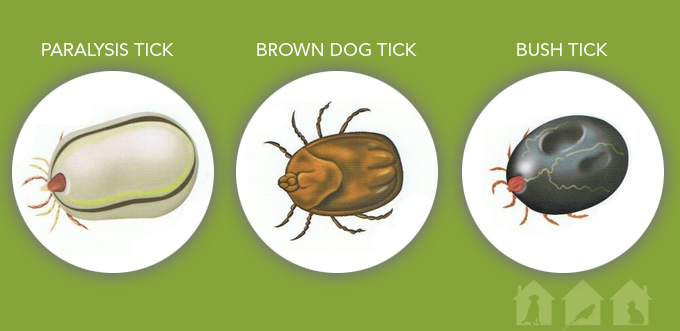
Every year, pets across Brisbane die from tick paralysis. Wet weather and warmer temperatures in the summer are the ideal time for paralysis ticks to be out in force. That is why it is important to be aware of the dangers they pose to your pets and to know what to do if you think they may have been bitten.
In this post, we outline everything you need to know about paralysis tick bites in Brisbane, from what they are, their symptoms and ways to prevent infection and tick paralysis.
What Is A Paralysis Tick?
Ticks are a small insect that attaches to the skin of an animal or person. There are many different species of the tick, including the brown dog ticks and bush ticks. However, the one that often causes the most concern in Brisbane to pets and people alike is the paralysis tick. Although it can be difficult to differentiate between Australian ticks, there are some physical differences that allow us to better spot paralysis ticks from their bush tick and brown dog tick counterparts.
An adult paralysis tick can be as small as a pinhead when it first attaches to your pet, but over several days it can grow to the size of a thumbnail once fully engorged! Paralysis ticks are generally grey in colour with all of their legs being concentrated towards the head of the tick.
Are There Paralysis Ticks in Brisbane?
Yes! Paralysis ticks (Ixodes holycyclus) can be found throughout most of Brisbane but are particularly prevalent in the Western Suburbs due to the large areas of dense bushland still found in these suburbs.
These Australian ticks thrive in this environment. Here they feed on native wildlife such as possums and bandicoots, which are generally unaffected by the paralysis tick toxin. Although ticks are more prevalent in summer, they generally pose a year-round threat in South East Queensland, owing to our temperate climate.
If you are not sure what type of tick is on your dog, be sure to give the experts at The House Call Vet a call to assist in identification and emergency treatment. Tick bites and tick paralysis pose a very real risk if not treated promptly.

What Are The Symptoms Of A Tick Bite?
While most tick species are harmless, paralysis ticks are much more than a nuisance and pose a serious threat to the health of your furry companions.
These ticks cannot jump like fleas, but will sit on grass blades and leaves where they can easily attach to a host walking by. While feeding, a paralysis tick secrets toxic saliva into the bloodstream that attacks the nervous system directly, leading to the loss of voluntary movement of your beloved companion.
In most cases, tick paralysis in dogs can be seen within 3-4 days of the tick attaching itself. The signs that you will most commonly see if your pet is affected are:
- Change in the tone of bark
- Coughing, gagging or vomiting
- Lack of appetite
- Obvious drooling and lack of swallowing
- Trouble standing up
- Wobbly on legs
- Unable to use or weakness in back legs
- General weakness or lack of coordination
- Trouble blinking that usually starts in one eye
- Difficulty breathing. This will sound like the pet is grunting when breathing out
It is important to remember that tick paralysis in dogs is life-threatening and it is essential that you contact your local vet immediately if you think they are affected.
Read More: Staying Calm in a Pet Emergency


Performing A Tick Search On Your Companion
Regular checks are key when it comes to protecting your companion from the dangers of tick bites and paralysis ticks – both during tick season and the rest of the year. To perform a tick search, gently work your hands through your companion’s coast. While they can attach anywhere on the skin, be sure to concentrate your search in these areas:
Head & Ears
Pups are curious creatures. They love to sniff and stick their heads into everything, so it is common for ticks to attach to their heads and ears. With so many folds, the ears make the perfect hiding spot for paralysis ticks.
Toes & Under The Legs
When going for walks, especially in areas that have a dense bush, it is common for most ticks to find their way in between your dog’s toes and paw pads or where their legs meet their body. While it is common in skin irritation and allergic reactions, if you notice your pet chewing or licking their feet, it could indicate a tick bite.
Under The Collar
For dogs who rarely take their collars off, ticks can be commonly found attached underneath the collar. These ticks often go unnoticed until they have eaten enough and are large enough to be seen. This makes regular checks crucial!
Under The Tail
The underside of your dogs belly and tail are typically dark, moist areas – which are the ideal environment for ticks to thrive. Most owners rarely inspect the underside of their companion’s tails, which means ticks can go unnoticed for some time. For dogs with thicker fur, this can often also be the case – however, regular inspections can ensure that ticks can be caught early and removed.
Eyelids
Many times ticks can go unnoticed near the eyelids because they can be mistakes for discharge or skin tags. It is only when they have become engorged and large that owners notice. This, however is dangerous as the longer a tick stays attached the more likely your companion is to get sick.
What Do I Do If I Find a Paralysis Tick?
Finding a tick can be scary! You will find yourself asking – should I remove the tick? How do I get rid of it? Quick action is crucial and it is recommended that you remove the tick immediately.
Grasp the tick as close to your pet’s skin as possible using your fingers or a set of tweezers. Then twist and firmly pull on the tick to remove it. Take care not to separate the head from the body. After removal, keep the tick for identification purposes and contact your vet if your pet begins to display signs or symptoms of illness.
Read More: Your Pet’s First Vet Visit: What To Expect & How To Prepare

How Do I Protect Against Paralysis Ticks?
It’s never too late to start a paralysis tick prevention routine. Not only does it reduce the risk of heavy infestations, saves you from the emotional distress of seeing your pet unwell, and the financial burden of treating tick-related illnesses.
Tick Collars and Topical Treatments: Invest in quality tick collars and topical treatments such as spot ons. These act as a barrier against ticks, providing long-lasting protection for your pet.
Avoid Tick-Prone Areas: Be mindful of your surroundings. Avoid areas known for high tick prevalence, especially during peak seasons. Stick to well-groomed and tick-free zones for outdoor activities.
Regular Washing and Coat Checks: Maintain a regular grooming routine for your pet. Wash their coat and conduct thorough checks, feeling for any unusual bumps or ticks hidden in their fur.
Protect Your Pets From Paralysis Ticks
It goes without saying that the threat of paralysis ticks in Brisbane is real. However, with the right preventive measures, we can reduce the risk of serious illness and ensure our pets live a happy and healthy life!
At The House Call Vet, we understand the importance of comprehensive care for your four-legged friends. That’s why we offer an extensive range of everyday veterinary services, ensuring your pet receives the best treatment and care they deserve. From routine check-ups and vaccinations to after-hours and emergency care, our dedicated team is here for you and your pet every step of the way.

